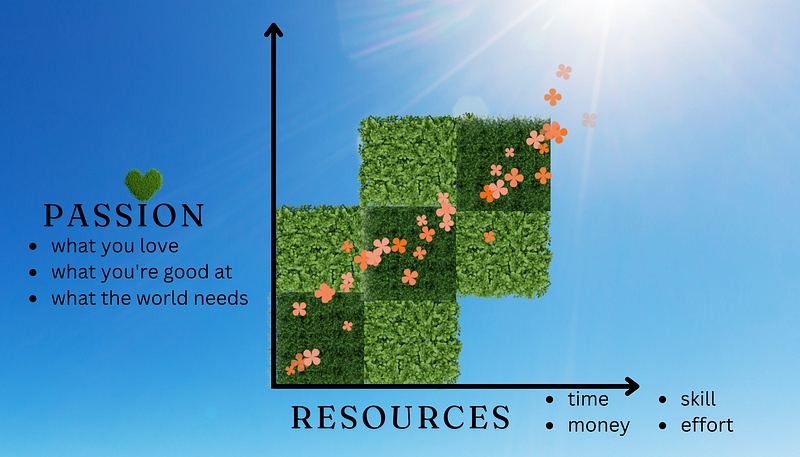Gardening Your Community: Simple Steps for Positive Change
Written on
Chapter 1: The Essence of Altruism
Sometimes, it feels like discussions about altruism outnumber the individuals actually engaged in charitable acts. People often debate over motivations, priorities, and the effectiveness of various approaches to making the world a better place. The question remains:
How can we improve our world?
This is a vast and intricate topic that can be quite daunting. However, amidst the debates are many individuals who quietly dedicate themselves to good deeds. I refer to this group as the "shoulder-shruggers and shirt-sleeve-rollers" (SSASSR). Rather than engage in arguments, they roll up their sleeves and get to work.
These everyday heroes clean parks, provide meals for the needy, teach literacy, and care for the world around them. Their impact may not be loud, but they are a continuous source of positivity. My experiences alongside them have enlightened me on the nature of altruism, its significance, and the common barriers people face. They have shown me how to contribute meaningfully in modest ways.
Section 1.1: Defining Good Works
In the Christian context, good works are actions that promote charity, compassion, and kindness—essentially, "loving thy neighbor." From a secular viewpoint, I define good works as voluntary actions that improve our surroundings.
In other words, volunteering involves a genuine desire to help others. Unlike selfless altruism, personal motivation plays a crucial role in sustaining long-term involvement. Consider the concept of Ikigai, minus the aspect of financial reward. What remains is:
- What you love
- What you excel at
- What the world needs
Section 1.2: The Importance of Good Works
A 2013 meta-analysis of forty studies revealed that volunteering positively affects mental health, life satisfaction, and overall well-being, although its impact on physical health was unclear. The findings suggest that volunteering reduces mortality risk, indicating an innate human tendency to care for one another.
This impulse is essential for our survival, as it enables us to empathize. We often feel uplifted when we positively impact others. Yet, the lack of financial incentives can make it difficult for many of us to find time for altruism, especially amidst rising living costs and economic disparities.
Moreover, our culture often promotes artificial solutions that fail to meet fundamental needs across Maslow’s hierarchy. We consume fast food that leaves us unsatisfied, rent homes that lack the stability of ownership, and engage in superficial online connections. This environment can hinder self-esteem and self-actualization.
Despite the popularity of self-help literature, true fulfillment often eludes us. While seeking personal growth, we may overlook the neglected areas in our communities, which reflect our inner voids.
Chapter 2: Overcoming Barriers to Volunteering
Video Description: Discover practical tips for cultivating large cabbages in your garden, contributing to your community, and growing your gardening skills.
The perception that charity is primarily the domain of the wealthy or religious can deter individuals of modest means from participating. This belief can create feelings of inadequacy and isolation. However, grand gestures often create divides.
Self-sacrifice can come off as self-righteous, making recipients feel worse about their situations. The notion that charity must be entirely altruistic can discourage potential volunteers. Yet, we often derive personal satisfaction when others recognize our efforts to help.
Additionally, the misconception that financial resources are necessary to contribute can be misleading. You don’t need to donate large sums to make a difference. Many organizations operate hierarchically, which can alienate those they intend to assist.
Section 2.1: Taking Action in Your Community
Now that we’ve addressed these barriers, how do we embark on meaningful contributions in our communities? The abundance of causes can feel overwhelming, but it starts with self-reflection on your passions and interests.
Begin by exploring your local community. Consider visiting:
- Parks
- Libraries
- Hospitals
- Shelters (including animal shelters)
- Museums
- Community centers
Don't forget about your neighbors; sometimes, a simple introduction can lead to opportunities for collaboration.
Section 2.2: Aligning Goals with Causes
Identify some personal goals, such as:
- Improving fitness
- Learning a new skill or language
- Exploring a hobby
- Meeting new individuals
Next, connect these goals with causes that resonate with you, like:
- Environmental stewardship
- Supporting the less fortunate
- Advocating for rights (human or animal)
These elements form the foundation of your passion and will guide your contributions.
The Path to Making a Difference

Start small—choose one goal and one cause that require minimal resources. For instance:
- If you’re focusing on fitness and care about the environment, look for community cleanup events while exercising.
- If you’re interested in a new hobby and want to help others, seek out volunteer groups related to that hobby.
- If you aim to enhance skills while assisting those in need, consider teaching opportunities at your local library.
- If you want to meet new people and advocate for human rights, join existing groups and engage at your own pace.
Remember, the first step is often the hardest. Gathering information and introducing yourself may take effort, but these small actions can lead to significant contributions.
Lastly, don’t feel compelled to continue if your circumstances change. It’s entirely acceptable to adjust your involvement based on your life situation. The true essence of volunteering is finding joy in helping others while also benefiting personally.
In conclusion, dismiss any notions that guilt should accompany your good works. Instead, embrace the idea that mutual benefit enhances your contributions. Together, the small patches we nurture can create a vibrant tapestry of positive change in our communities.
Thank you for reading! For more insights, follow my journey. I also publish articles on mindful living and creative self-expression:
Seven Mindful Muses
A collection of articles focused on growth and self-improvement through mindfulness and creativity.
Video Description: Join us for a sneak peek of our garden, tiny house, and the latest updates on our homesteading journey.